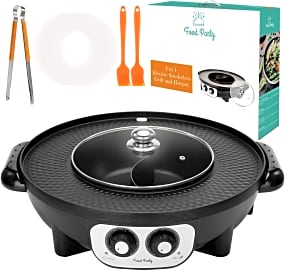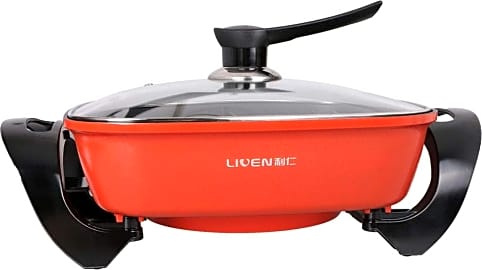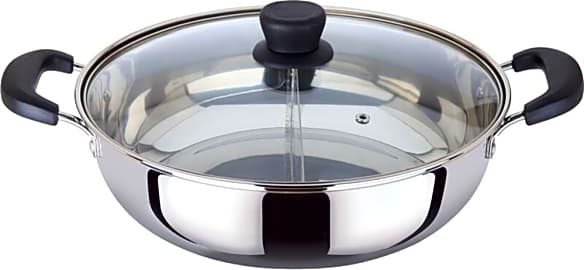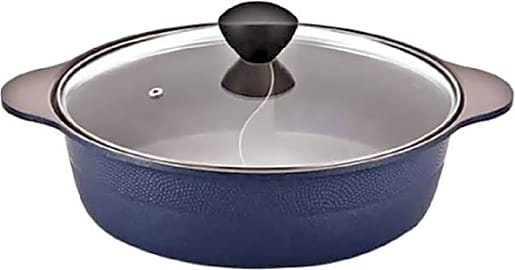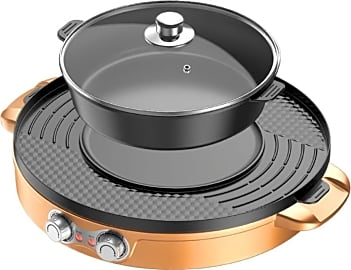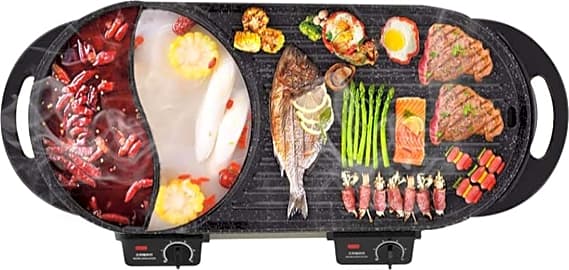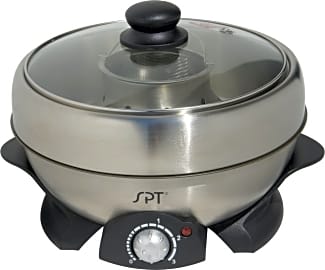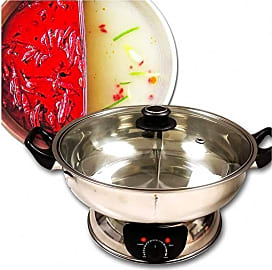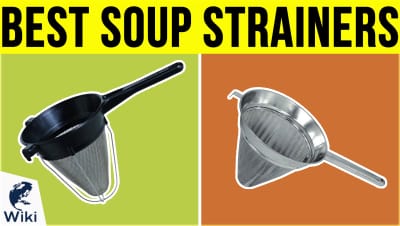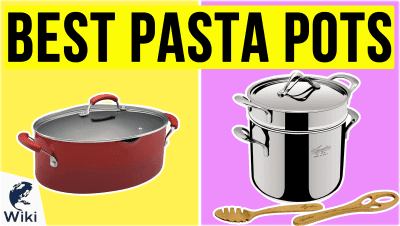The 10 Best Shabu Shabu Pots

This wiki has been updated 35 times since it was first published in January of 2017. If you’re in the mood for some shabu-shabu at home, you won't get very far without a quality pot. We've included options made from a variety of materials and boasting different capacities to suit most needs. Dip sliced meats and veggies into these for a dish that's healthy, shareable, and interactive. They act as both the cooking and serving vessel, for an easy cleanup. When users buy our independently chosen editorial selections, we may earn commissions to help fund the Wiki.
Editor's Notes
November 28, 2020:
In making our list of shabu shabu pots, we wanted items that help create an authentic Japanese dining experience in your kitchen, as well as those with features that make the cooking process easy. Durability was important, as was including a range of sizes for parties big and small.
The MyLifeUnit Yin Yang stood out in the longevity category, with a stainless steel construction and welded divider. We also appreciate the aluminum build of the Liven SK-J6860. The HCX 30 Dual Sided FP013 dents too easily, and the CookLover Ceramic also suffers durability issues, so we removed those two models during this update. Though we appreciated the steel construction of the Kotobuki Traditional, we did wish its handles were of another material that didn't get too hot, like those found on the Sonya SYHS-30, so we removed it.
If you're hosting a dinner gathering, we have included several models that can come in handy. The Liven SK-J6860 has a large barbecue, in addition to a hot pot, and both the Food Party 2 in 1 and the Seaan Electric 2200W have generously-sized grills surrounding their hot pots. Should you prefer having one of these all to yourself, you might like the PartiPot Entertaining Set, which is a pair of individually-sized units.
We did not feel that the Liven HG-X1001PK has a design that closely resemble a genuine shabu shabu pot, so we eliminated it. If you want something authentic and simple, there is the Sonya SYHS-30. Meanwhile, if you need a multipurpose item, the SPT SS-301 Multi-Cooker has a strainer, grill, and pot.
March 12, 2019:
It's no secret that lovers of Shabu Shabu have an appreciation for versatile and efficient cooking tools, which is why we included some models designed to make a range of dishes, like the SPT SS-301 Multi-Cooker, with its variety of cooking attachments that take food from raw to ready in several ways. There's also the convenient and portable Liven HG-X1001PK, which is great for making everything from noodles to oatmeal and ready for dorm-living. Not everyone at the table will have the same tastes, so we also included models like the CookLover Ceramic, Liven HG-301AY, and Sonya Hot Pot, each of which have dividers, allowing you to keep ingredients for spice-lovers on one side, and milder food on the other. Traditionalists seeking only the most authentic dining experience will love the City ST CH-8802, which is much like those you'd find at a Japanese restaurant, and the Kotobuki Traditional, which is probably like one you'd find in the home of a Japanese family.
Special Honors
Kangyuanshuai Yin Yang Hot Pot Made of food-grade stainless steel and weighing less than three pounds, the Kangyuanshuai Yin Yang Hot Pot is durable yet lightweight. It has a thick glass lid that lets you keep an eye on your ingredients, strong welded divide, and comes with two spoons. walmart.com
What Exactly Is Shabu Shabu?
It is still serving the dish to this day too, so if you are a shabu shabu lover and ever happen to find yourself in Osaka, we strongly recommend you check it out.
Maybe you've heard the name before, or walked by a restaurant advertising this strange-sounding dish, and wondered what exactly this mystery food is. Simply put it's a hot pot, which is somewhat similar to fondue for those not overly familiar with Asian food. It falls into what the Japanese classify as nabemono. Nabemono refers to a variety of different one-pot dishes that are kept hot at the dining table, usually by the use of portable electric or gas stoves.
Shabu Shabu consists of a variety of thinly-sliced meat, seafood, and fresh vegetables, which are all cooked together in a large pot of broth. Differentiating it from many other forms of nabemono, in which all of the ingredients are cooked together before serving, is the fact that the diner cooks each ingredient themselves at the table, so don't be surprised if you go to a Japanese shabu shabu restaurant and are served a plate of raw meats and veggies. Shabu shabu is always accompanied by dipping sauces of some kind, most often ponzu and sesame. In many places, you will also be given a variety of other condiments to flavor the sauce to your liking, including green onions, grated daikon, and shichi-mi tōgarashi chili powder.
While nabemono has been popular in Japan for thousands of years, shabu shabu is a more recent addition to their cuisine. It is believed the popular Suehiro restaurant in the Kita-ku ward of Osaka first introduced it in the 1950s. It is still serving the dish to this day too, so if you are a shabu shabu lover and ever happen to find yourself in Osaka, we strongly recommend you check it out.
How To Eat Shabu Shabu
So, now that you know what shabu shabu is, let's discuss the proper way to eat it. After all, you'd hate to be that gaijin who sits down at a shabu shabu restaurant on your first trip to Japan and starts eating the broth with a spoon, making all of the other patrons nearby cringe.
After dipping your meat, seafood, or vegetable in the sauce, you should rest it on top of the rice for a couple of seconds before eating it.
After the pot of broth is brought to your table and placed on the stove, cover it until it comes to a boil. While you are waiting for this to happen is the perfect time to customize your sauce. We recommend adding the green onions to the sesame sauce, and the togarashi and grated daikon to the ponzu sauce, though this is entirely up to you. Once the broth reaches a roiling boil, reduce the heat to a slight simmer. Shabu shabu broth is meant to be kept gently simmering, rather than violently boiling as with Chinese and Mongolian hot pots.
Start by adding some of the harder vegetables, like carrots and radishes, as well as the tofu, as these ingredients will take longer to cook. Once the broth comes back up to a simmer, you can begin to add the other ingredients. Since the leafy greens, seafood, and meat will cook rapidly, you should add those one by one as you plan on eating them. Don't cook more than one or two pieces of meat at a time. Not only do you wind up risking overcooking the meat, but it will lower the temperature of the broth, too. As you cook the meat and seafood, you should gently swish it around in the cooking liquid with your chopsticks.
After you remove an ingredient from the broth, whether it be meat, seafood, or vegetable, dip it into the sauce. Generally the ponzu is used for the vegetables and seafood, and the sesame is used for the meat. This isn't a hard and fast rule however, so feel free to experiment. After dipping your meat, seafood, or vegetable in the sauce, you should rest it on top of the rice for a couple of seconds before eating it. This gives it a chance to cool down, as well as allowing the rice a chance to absorb some of the flavor, turning that into a wonderful delicacy in its own right.
Choosing The Right Shabu Shabu Pot
Shabu shabu pots come in a few different materials and styles, each of which offers certain benefits. For example, you can choose to buy one made from ceramic, cast iron, steel, or aluminum. Both ceramic and cast iron models take a long time to heat up, but on the flip side, they retain their heat for longer. This means you generally won't have to keep your stove turned up as high during the cooking process as you would with a steel or aluminum pot. Ceramic and cast iron differ in their care and durability, however. Ceramic is easier to care for. There is also no chance of it leaking any metals into the food or altering its flavor in any way. The downside to ceramic is that it is significantly less durable than cast iron. If you are clumsy and tend to drop your dishware when you wash it, you may want to skip a ceramic shabu shabu pot.
Unfortunately, they are prone to rusting if not properly seasoned and cared for.
On the other hand, cast iron pots are extremely durable — practically indestructible, in fact. Unfortunately, they are prone to rusting if not properly seasoned and cared for. You may be able to find an enameled cast iron model that won't suffer from rusting issues, but they are often very expensive. Cast iron is also quite heavy, and considering how large shabu shabu pots are, this can make them difficult to handle. Both cast iron and ceramic pots usually require hand washing.
Steel and aluminum pots are lightweight, durable, and some can even be thrown in the dishwasher. The downside is they don't retain heat very well, meaning you'll probably run through a bit more gas during dinner time. Of course, if you choose an electric stove, this won't be an issue. One of the greatest benefits of aluminum and steel shabu shabu pots is that they come in some unique styles, such as in a split-pot design that allows you to serve your guests two broths in one meal, or with a grill surface, both of which can bring shabu shabu night to a whole new level.


